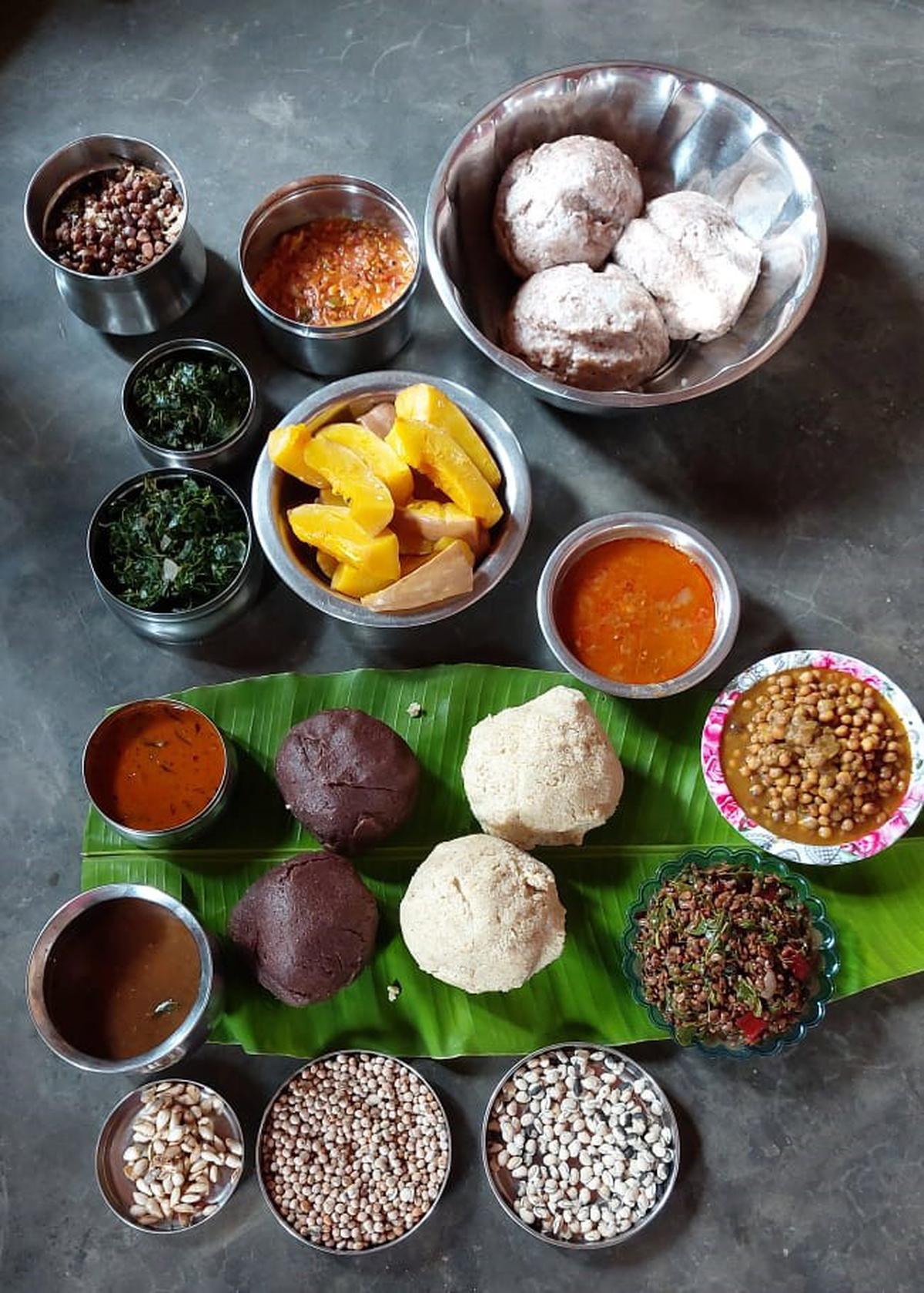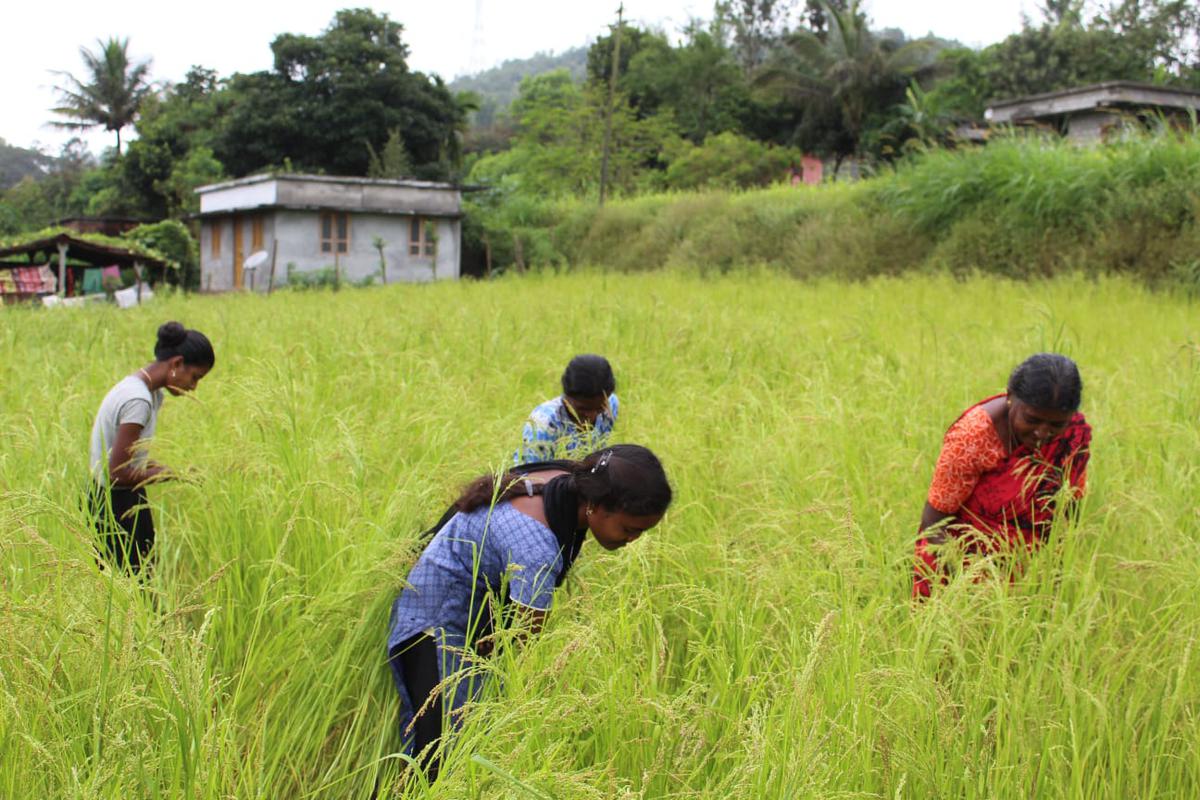Even as Attappady continues to be the leader in millet cultivation in Kerala, it is being promoted in other parts of the State as well
Even as Attappady continues to be the leader in millet cultivation in Kerala, it is being promoted in other parts of the State as well
Dosa with five varieties of millets and payasams cooked with millets are just two artisanal foods on the menu of Millet Cafe at Pudur in Attappady taluk, Palakkad district. The four-month old cafe, run by three tribal women, serves a variety of millet-based dishes.
The cafe is one of the many initiatives of Kudumbashree (the State Poverty Eradication Mission of Kerala Government) to promote millet cultivation. Kudumbashree is also involved in the manufacture of value-added products from millets in Attappady, which has, for long, been the millet capital of Kerala, thanks to its tribal population. Kudumbashree has its own brand, Hill Value, to market farm and forest produce cultivated by the tribals and the Millet Cafe is their latest addition (see box).
The success of millet farming in Attappady has motivated other districts in Kerala such as Alappuzha. Last year, Cherthala South panchayat in the district, cultivated ragi (finger millet) on over 250 acres spread across 22 wards. It was perhaps the first time that a millet variety was grown on such a large scale in south Kerala.
The panchayat went for a second round of cultivation early this year, earned a good harvest and is now all set for large-scale cultivation after the monsoon.
All these years, much of the millet cultivation in Kerala has been concentrated in Attappady, which is home to three tribal communities — Irulas, Mudugas and Kurumbas. Millets are integral to their diet and in 2017-18 the Kerala Government launched the Millet Village scheme in Attappady to support traditional agricultural practices of these communities. It was jointly implemented by Department of Agriculture and Scheduled Tribes Development Department. Idukki and Wayanad districts also have millet farms, mostly in tribal settlements.
With the United Nations declaring 2023 as the International Year of Millets, they are back as a superfood. Millets have high protein content, are resilient to climate variations, requires less water for irrigation and is ready for harvest over a short period of time.
According to Rosmy George, agricultural officer with Krishi Bhavan, Cherthala South, it was the success story of Attappady that inspired her and her team to try millet farming in their panchayat. The cultivation was launched by clubbing it with Mahatma Gandhi National Rural Employment Guarantee Act (MGNREGA), known colloquially as Thozhilurappu Padhathi. “The women labourers had no other means of income because of the pandemic and lockdown. Under MGNREGA they were assured of employment. Even though we were not sure if ragi would grow in the sandy soil of this region, we went ahead with it. Households were also covered. It was done by 220 MGNREGA groups, each consisting of 10 to 20 members. Since the lockdown was in force, we could train them only through WhatsApp. We concentrated on ragi because it has a better market. We had a good harvest of around 2.1 tonnes per hectare (2.47 acres),” says Rosmy.

Ragi harvested from farms at Cherthala South panchayat
| Photo Credit: SPECIAL ARRANGEMENT
She adds that the crop was successfully grown in the coastal wards as well. “These wards, which lie close to the beach, are thickly populated and it is not possible to grow anything there because the waves would wash them away. That didn’t happen with ragi and the fisherfolk were enthused about growing it.”
In the second phase, ragi was cultivated in 25 acres by individuals and groups and among them were those who had a good harvest in the first round of cultivation. “In the first phase, our 20-member group harvested over 300 kilograms from 1.5 acres,” says Rangabai, a resident from the panchayat. “People came from across the district to buy ragi grains and we converted the rest of it into flour. In the second round, farming was done by our eight-member agri group, Haritha. Although we cultivated it on a small piece of land, we got over 170 kilograms. We are now getting the land ready for another round of cultivation.”
Millets on the menu
The Millet Cafe has different snacks and dishes made using millets. The menu has ragi chapathi, millet dosa, thina lemon rice, thina dosa, ragi puttu,varagu payasam, mixed millet dosa, vegetable millet uppumavu, payasams made with chama or kambu,chama uppumavu or dosa or curd rice, and corn uppumavu or puttu. Among the snacks are ragi banana fritters, ragi ilayada or ragi chicken bonda.
Resi Rangan, Lakshmy Vellingiri and Jayalakshmy Veluswamy, members of the tribal community, who prepare the dishes. “They are getting a steady income. Millet dosa is a big hit with the customers. The dough has chama, thina, ragi, kambu, varavu and urad dal. We are trying to make new items, including chama biriyani,” says Uma Selvaraj who coordinates the activities of the café.
According to Remadevi S, also from the panchayat, ragi used to be grown in several households many years ago since it was integral to the diet of new-born babies. “We grew it in the basins ( thadam) dug around coconut trees. That went out of practice eventually. So it was exciting to return to that farming after so many years. We got around 96 kilograms and it was sold at ₹90 per kilogram,” she says. The Krishi Bhavan also grew millets on their office premises along with vegetables.
The plan is to increase the area under ragi cultivation in the next financial year, says Rosmy. “We plan to involve 100 groups in this. Also, we are looking at making value-added products from ragi other than the flour,” she adds.
Leading from the front
Millets are cultivated on 1,200 hectares over the two cropping seasons in Attappady. This include farms managed by Department of Agriculture, Kudumbashree and Tribal Department, explains Latha R, assistant director of agriculture (Attappady), Department for Agriculture Development and Farmers’ Welfare.

Some dishes at Millet Cafe
| Photo Credit: SPECIAL ARRANGEMENT
Besides ragi, chama (little millet), thina (foxtail millet), varagu (kodo millet), panivaragu (proso millet), manicholam (sorghum), kambu (bajra) and kuthiravali (barnyard millet) are cultivated. The millets are grown in 192 hamlets, out of which 74 comes under the Agriculture Department. ‘Pancha krishi’ or the indigenous farming practice of cultivating different crops is being revived. With millets, pulses, vegetables, grain amaranth and the like are cultivated.
Kudumbashree’s role

‘Chama’ or little millet cultivation
| Photo Credit: SPECIAL ARRANGEMENT
Groups under Kudumbashree grow six millet varieties in 665.49 acres. In 2019, it launched the Hill Value brand and also revived Kambalam (see box), an age-old custom of the tribals to welcome the monsoon, under Attappady Adivasi Comprehensive Development Project.
Agri festival
“Ritualistic songs and dance make Kambalam a festive occasion with heads ( moopan) of the hamlets leading the celebration,” says Shaiju. Traditional songs are rendered by groups and they dance to the beats of instruments as they sow seeds. It could not be held in the last two years because of the pandemic. This year, the first event was held on May 20 at Kallakkara hamlet, where 22 farming groups are cultivating on 42.4 acres, followed by programmes at Moolakombu and Kunnanchala hamlets. Kambalam will be held till June end in 20 hamlets, involving 4,606 women farmers of 1,037 farming groups. Kudumbashree’s ooru samithis conduct the event in association with panchayat samithis.
Meanwhile, the Agricultural Department is all set to open a millet processing unit at Attappady. Attapady Tribal Farmers Association for Millets, an FPO (Farmer Producer Organisation), will handle the mill and marketing.
“The farmers have realised that there is no dearth of market for millets and value-added products. They are now assured of a better income. A proposal has been submitted to the Central Government for a secondary processing unit to manufacture products such as noodles, pasta and flakes from millets. “The pandemic had slowed down procurement. Also they were unable to sell the produce because there were no exhibitions or fairs. However, things are slowly getting back on track,” Latha says.

Kambalam is the agri festival of the tribal communities in Attappady to herald monsoon. They sing traditional songs and dance to the beats of instruments as they sow seeds of millets, pulses and vegetables
| Photo Credit: SPECIAL ARRANGEMENT
Plans are on to bring out new products under Hill Value brand, says Shaiju E, project coordinator, Attappady Comprehensive Tribal Development Programme. “Better marketing strategies have to be in place to keep this running. Also, steps should be taken to protect the crops from attack of wild animals,” he points out.
























